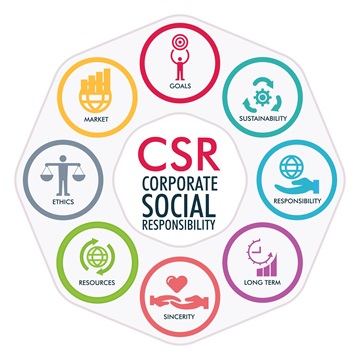View News
The-Symbiotic-Relationship-CSR-Activities-Influence-on-Corporate-Reputation-and-Brand-Image-in-the-Legal-and-Economic-Contexts

The Symbiotic Relationship: CSR Activities' Influence on Corporate Reputation and Brand Image in the Legal and Economic Contexts
~Sura Anjana Srimayi
INTRODUCTION
Corporate Social Responsibility (CSR) has come a long way from being a marginal philanthropic endeavor to becoming a central part of business strategy. Its influence goes far beyond simple altruism, with far-reaching implications for a company's reputation and brand image, especially within the crucial paradigms of the legal and economic contexts. A strong CSR program can serve as an impregnable bulwark against legal action, build stakeholder trust, and eventually lead to lasting economic viability. The opposite, a lack of sincere CSR or worse, and the practice of deceptive "greenwashing," can result in dire legal consequences, erode brand capital, and harm financial performance.
Defining Corporate Social Responsibility, Corporate Reputation, and Brand Image
To understand the impact of CSR, it is crucial to define the key terms:
- Corporate Social Responsibility (CSR): This includes a firm's adherence to ethical and sustainable practices that contribute positively to society and the environment beyond compliance with the law. It encompasses activity in environmental sustainability, ethical business practices, community involvement, and corporate governance.
- Corporate Reputation: This is the general impression of a company among its stakeholders, such as customers, investors, employees, regulators, and the public. It is established over time through sustained actions and communications. A good reputation indicates trust, reliability, and ethical behavior.
- Brand Image: This refers to the particular collection of associations, beliefs, and emotions stakeholders have towards a specific brand. It tends to be more concerned with the marketing and consumer-related functions of a firm, impacting buying behavior and brand loyalty. Although different, brand image is an important part of corporate reputation as a whole.
CSR as a Risk Mitigation and Compliance Tool
In the legal arena, proactive and authentic CSR activities can effectively reduce risks and improve compliance.
- Evading Legal Sanctions and Fines: Firms that give high value to environmental sustainability and ethical labor practice will be less likely to be taken to court over pollution, exploitation of workers, or human rights issues. Investing in effective environmental management systems, paying wages and wages at the same level, and obeying ethical procurement practices can help avoid costly litigation, fines from regulators, and brand destruction due to legal violations. Example: Over the past few years, some multinational companies have incurred major legal and financial consequences for environmental pollution mishaps. Those firms that had made investments in advance of pollution controls and open environmental disclosure were generally better able to ride out such crises with less adverse legal and reputational fallout than firms that were lax on environmental issues. Likewise, firms with good records on labor compliance have been better equipped to fight against lawsuits on allegations of unfair labor practices.
- Strengthening Regulatory Relations: Firms with a good CSR history tend to have improved relations with regulatory agencies. Showing care about social and environmental welfare may result in increased trust and possibly more lenient regulatory supervision. Regulators are likely to be more willing to work with and provide more flexibility to firms viewed as responsible and responsive to social issues. Example: Firms in highly regulated sectors, like energy or pharmaceuticals, that openly communicate with regulatory bodies regarding their CSR efforts, such as safety procedures and environmental studies, tend to create a less confrontational and more cooperative relationship. This can result in easier approvals for new projects and a more stable regulatory climate.
- Building a Social License to Operate: In most industries, and especially those with extensive environmental or social influence, securing and sustaining a "social license to operate" is paramount. This tacit endorsement from local stakeholders and communities usually depends on the company's proven commitment to CSR. Neglecting to deal with concerns of communities or practicing responsible business can result in demonstrations, litigation, and delays or cancellations of projects. Example: Extraction or infrastructure activities that have overlooked local concerns for environmental management or resettlement have often run into judicial controversies and delays lasting many years due to a failure of securing social license to operate. Companies, on the other hand, which approach communities openly, introduce high-quality environmental controls, and benefit the development of surrounding communities are better positioned to achieve acceptance by local populations and eschew legal problems.
The Economic Sphere: CSR as a Driver of Value Creation
- Building Brand Image and Customer Loyalty: Customers are becoming increasingly aware of the social and environmental consequences of products and services bought by them. Organizations that genuinely believe in CSR tend to enjoy a good image, resulting in higher customer loyalty, willingness to pay extra prices, and good word-of-mouth publicity. Example: The growth in sustainable and ethically sourced products is a manifestation of this trend. Companies that openly declare their focus on fair trade, environmental sustainability, and ethical sourcing tend to gain a devoted customer base that appreciates the ethics and is willing to pay a premium for products that resonate with their ethics. The past few years have witnessed a tremendous surge in such demand from consumers, reflecting directly in the market share and profitability of firms with excellent CSR credentials.
- Attracting and Retaining Talent: In the modern competitive job market, a company's social responsibility reputation is a major determinant in attracting and retaining talent. Workers are looking for employers who share their values and who show they care about creating a positive influence. A well-established CSR program can increase employee morale, motivation, and commitment, resulting in lower recruitment expenses and enhanced productivity. Example: Organizations that have a high reputation for their CSR activities, like offering volunteer opportunities, investment in employee well-being, and diversity and inclusion, tend to have higher levels of employee satisfaction and lower rates of turnover. This translates to considerable cost reductions in recruitment and training and an improved pool of skilled and motivated employees. Surveys over the past few years consistently indicate that younger generations specifically value working for organizations with a high ethical and social values culture.
- Enhancing Investor Relations and Access to Capital: Investors are increasingly making investment decisions based on Environmental, Social, and Governance (ESG) considerations. Such companies with a good ESG performance, which is directly related to CSR, tend to be perceived as having reduced risk and sustainable long-term prospects, which brings them more investment and possibly lower capital costs. Example: Expansion of socially responsible investing (SRI) and ESG funds illustrates the enhanced significance of CSR among investors. Such firms enjoying transparent ESG disclosure and impeccable CSR records attract these investors often, thereby finding greater demand for their stock as well as the possibility of accessing capital markets easily. In the last few years, a rapid rise in ESG fund-based assets under management has served as a reflection of the financial salience of CSR.
- Driving Efficiency and Innovation: Sustainability commitment tends to spur innovation within products, processes, and business models. Organizations that concentrate on minimizing their environmental impact could find new, more efficient ways of doing business, which yield cost savings and competitive benefits. Example: Firms that invested in renewable energy sources or adopted circular economy concepts have frequently seen substantial cost benefits in energy use and waste reduction. The drive for sustainable practices can foster design innovation in products with the result of more resource-scarce and environmentally sound products that resonate with an increasingly large consumer group.
The Interaction of Legal and Economic Effects: Reputation as the Nexus
1) Corporate reputation is the key bridge between the legal and economic effects of CSR. Positive reputation, based on sincere CSR efforts, acts as a shield against legal problems and improves economic performance. On the other hand, negative reputation, based on the absence of CSR or unethical behavior, can result in both legal consequences and economic losses.
Example: A corporation that experiences a catastrophic environmental incident through negligence (a legal dilemma) will assuredly experience much reputational damage, resulting in boycotts, loss of consumer base, and reduction in the stock value (economic consequences). A corporation, however, which actively invests in environmental management and openly tells people about their actions is not as likely to encounter such accidents and is bound to be more positively perceived by the stakeholders and has a more favorable brand perception and economic performance.
2) The Risks of Disingenuous CSR (Greenwashing): Participating in "greenwashing," or misrepresenting a firm's products or operations as ecologically friendly or socially responsible when they are not, can carry heavy legal and financial penalties. Enforcement agencies are subjecting claims to more intense scrutiny, and consumers are paying closer attention. Being found out as having misrepresented the CSR position of a firm can result in litigation, enormous damage to its reputation, erosion of customer confidence, and damage to the bottom line.
Example: Some firms have been challenged in court and condemned in the media in recent times for issuing false claims regarding the sustainability of their products or their environmental footprint. Such cases of greenwashing can critically harm a firm's reputation and destroy the trust of consumers, resulting in boycotts and financial losses that could be much more extensive than the expense of putting in place real CSR measures.
CONCLUSION
Finally, the effects of CSR initiatives on company reputation and brand reputation in the legal and economic environment are deep-seated and extensive. CSR initiatives' consistent and true pursuit not only assists organizations in avoiding legal challenges and developing stronger regulatory connections but also leads to economic value generation through greater brand reputation, customer loyalty, recruitment of talented staff, better investor relations, and innovation. On the other hand, neglecting to give importance to CSR or practising fake CSR can attract serious legal consequences, damage to reputation, and adverse economic effects.
In the future, corporations should understand CSR as not just an add-on but a core aspect of their overall business strategy. Incorporating ethical and sustainable ethics into every part of the organization, complemented by open communication and serious commitment, is needed to create a robust corporate image, reinforce brand reputation, and attain long-term sustainable success in an increasingly aware and connected world. The economic and legal environments are increasingly entwined with societal demands for ethical corporate conduct, and CSR is becoming an indispensable necessity for long-term prosperity.
"Unlock the Potential of Legal Expertise with LegalMantra.net - Your Trusted Legal Consultancy Partner”
Disclaimer: Every effort has been made to avoid errors or omissions in this material in spite of this, errors may creep in. Any mistake, error or discrepancy noted may be brought to our notice which shall be taken care of in the next edition In no event the author shall be liable for any direct indirect, special or incidental damage resulting from or arising out of or in connection with the use of this information Many sources have been considered including Newspapers, Journals, Bare Acts, Case Materials , Charted Secretary, Research Papers etc.

